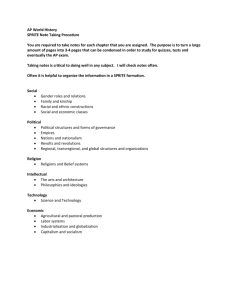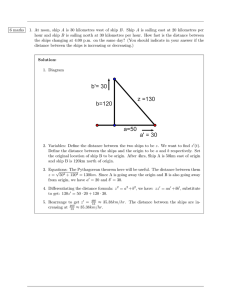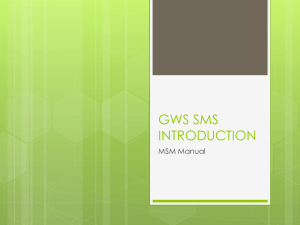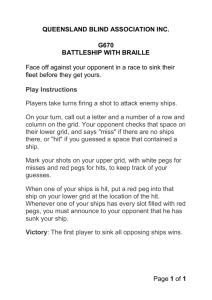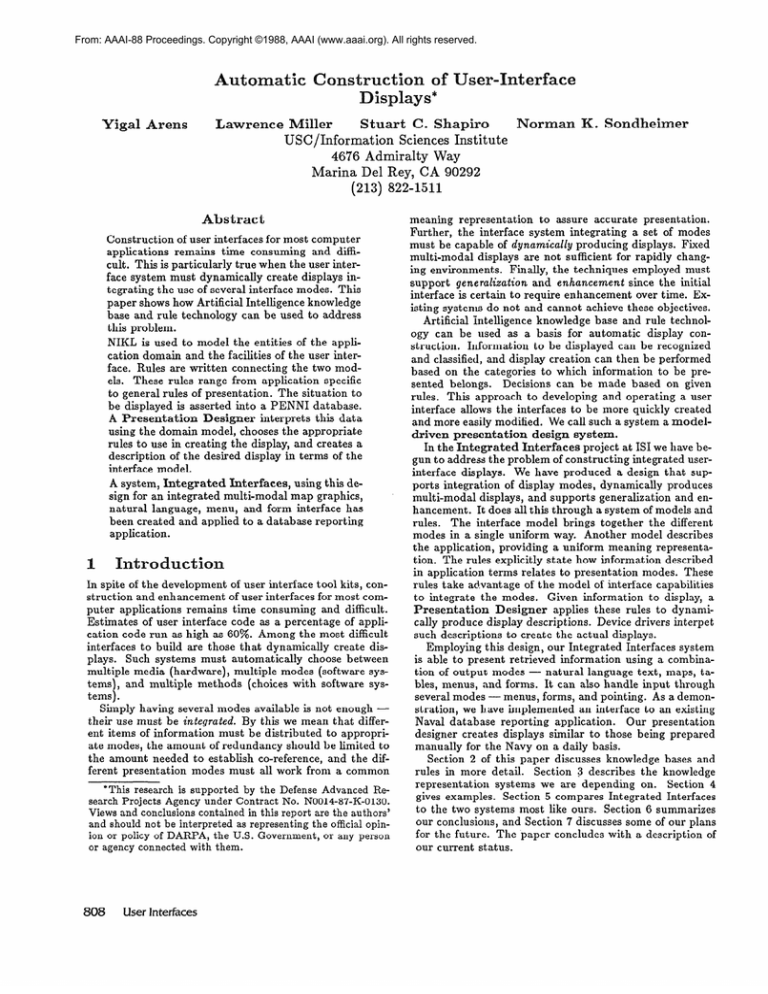
From: AAAI-88 Proceedings. Copyright ©1988, AAAI (www.aaai.org). All rights reserved.
Automatic
Uigal
Lawrence
Arens
Construction
of User-Interface
Displays*
Stuart C. Shapiro
Miller
USC/Information
Sciences Institute
4676 Admiralty Way
Marina Del Rey, CA 90292
(213) 822-1511
Abstract
Construction of user interfaces for most computer
applications remains time consuming and difficult. This is particularly true when the user interface system must dynamically create displays integrating the use of several interface modes. This
paper shows how Artificial Intelligence knowledge
base and rule technology can be used to address
this problem.
NIKL is used to model the entities of the application domain and the facilities of the user interface. Rules are written connecting the two models. These rules range from application specific
to general rules of presentation. The situation to
be displayed is asserted into a PENN1 database.
A Presentation
Designer interprets this data
using the domain model, chooses the appropriate
rules to use in creating the display, and creates a
description of the desired display in terms of the
interface model.
A system, Integrated
Interfaces, using this design for an integrated multi-modal map graphics,
natural language, menu, and form interface has
been created and applied to a database reporting
application.
1
Introduction
In spite of the development of user interface tool kits, construction and enhancement of user interfaces for most computer applications remains time consuming and difficult.
Estimates of user interface code as a percentage of application code run as high as 60%. Among the most difficult
interfaces to build are those that dynamically create displays. Such systems must automatically choose between
multiple media (hardware), multiple modes (software systems), and multiple methods (choices with software systems).
Simply having several modes available is not enough their use must be integrated.
By this we mean that different items of information must be distributed to appropriate modes, the amount of redundancy should be limited to
the amount needed to establish co-reference, and the different presentation modes must all work from a common
*This research is supported by the Defense Advanced Research Projects Agency under Contract No. N0014-87-K-0130.
Views and conclusions contained in this report are the authors’
and should not be interpreted as representing the official opinion or policy of DARPA, the U.S. Government, or any person
or agency connected with them.
808
User Interfaces
Norman
K.
Sondheimer
meaning representation to assure accurate presentation.
Further, the interface system integrating a set of modes
must be capable of dynamically producing displays. Fixed
multi-modal displays are not sufficient for rapidly changing environments. Finally, the techniques employed must
support generalization and enhancement
since the initial
interface is certain to require enhancement over time. Existing systems do not and cannot achieve these objectives.
Artificial intelligence knowledge base and rule technology can be used as a basis for automatic display construction. Information to be displayed can be recognized
and classified, and display creation can then be performed
based on the categories to which information to be presented belongs. Decisions can be made based on given
rules. This approach to developing and operating a user
interface allows the interfaces to be more quickly created
and more easily modified. We call such a system a modeldriven presentation design system.
In the Integrated Interfaces project at IS1 we have begun to address the problem of constructing integrated userinterface displays. We have produced a design that supports integration of display modes, dynamically produces
multi-modal displays, and supports generalization and enhancement. It does all this through a system of models and
rules. The interface model brings together the different
modes in a single uniform way. Another model describes
the application, providing a uniform meaning representation. The rules explicitly state how information described
in application terms relates to presentation modes. These
rules take advantage of the model of interface capabilities
to integrate the modes. Given information to display, a
Presentation
Designer
applies these rules to dynamically produce display descriptions. Device drivers interpet
such descriptions to create the actual displays.
Employing this design, our Integrated Interfaces system
is able to present retrieved information using a combination of output modes - natural language text, maps, tables, menus, and forms. It can also handle input through
several modes - menus, forms, and pointing. As a demonstration, we have implemented an interface to an existing
Naval database reporting application.
Our presentation
designer creates displays similar to those being prepared
manually for the Navy on a daily basis.
Section 2 of this paper discusses knowledge bases and
rules in more detail. Section 3 describes the knowledge
representation systems we are depending on. Section 4
gives examples. Section 5 compares Integrated Interfaces
to the two systems most like ours. Section 6 summarizes
our conclusions, and Section 7 discusses some of our plans
for the future. The paper concludes with a description of
our current status.
Figure 2: Fragment of Interface Model
Arrow, with its Course establishing the arrow’s Qrientation, and Text as a Tag presenting its Schedule.n
As can
Figure 1: Fragment of Application
Model
2
Presentation design is achieved in our system by the application of a system of antecedent-consequent rules. The
rules classify the information that needs to be presented
and map types of information to appropriate types of presentations.
2.1
Models
Our models characterize or define the categories of entities
our user interface can deal with.
The application
model identifies the categories of objects and actions in the application’s view of the world.
We indicate subclass relations present among categories,
as welI as relationships between objects and actions. For
the Naval database application, for example, we have a
class of ships, which has subclasses categorized by operational status. (See Figure 1 for a small fragment of this
model.)
The interface model describes the categories of objects
and actions of the interface world. The objects here include
windows, tables, maps, text strings, and icons. The actions
include creation, deletion, movement, and structuring of
displays. Describing all interface modes together in a single
model is a necessary basis of integration. (See Figure 2 for
a small fragment of this model.)
Only the application model needs to be created for each
new application interface.
2.2
Rules
The presentation rules are simple in essence: they map
objects from the application model into objects in the interface model. For example, a daily status report may be
mapped into a map. A position report may be mapped
onto a point on the map. A ship’s planned future activities may be mapped onto a text string. The following is a
paraphrase of part of a rule for the naval briefing application: “To display a Ship whose Mission is Mobile, use an
be seen, this rule takes its condition from the application
model and the rest of its vocabulary from the application
and interface models.
It is the rules in conjunction with the interface model,
that allow integration. They can be used to distribute information among modes, minimize redundancy, and coordinate presentations. For example, the above rule creates
an mixed graphic and natural language text display.
These rules are arranged according to the class subsumption hierarchy of the models. For example, the rules applicable to all ships are further up the hierarchy than those
applying only to ships on exercises.
We allow both ‘low-level,” application-specific rules,
rules.
The
and “high-level,” application-independent
above rule is an example of the first type. The following is an example of the second: “To request a Choice
Among Alternatives
when the Cardinality is Large, use a
Fill-in-the-Blank
From; otherwise use a Menu.”
2.3
ule Application
Presentation design can now be described as the task of
realizing the application domain categories within which
a request for information presentation falls, selecting the
appropriate rules that apply to those categories, and redescribing
the application terms in the request into appropriate presentation terms.
Realization relates the facts about instances to the abstract categories of the model. For example, the concrete
facts about Sprite, a ship with a malfunctioning radar,
must lead to the realization that it is a Disabled Ship.
Selection works by allowing for the appropriate mapping
rules to be chosen, allowing for additivity. Selection also
assures that all aspects of the demand for presentation are
met by some rule. Redescription applies the rules, mapping each aspect of a common-sense view of a presentation
into an equivalent presentation form.
The forms produced by rule application are not actually
the commands to the output subsystems (i.e., the map
graphics system, text generator, and the forms system).
Instead, they are interpretable by device drivers that control these systems.
Arens, Miller, Shapiro and Sondheimer
809
3
Knowledge
epresentation
TQOlS
Our implementation of presentation design depends on two
knowledge representation systems: NIKL and KL-TWO.
NIKL holds our models. KL-TWO automatically carries
out realization. KL-TWO also holds the demands for presentation and receives the forms read by the device drivers.
This section provides a brief introduction to these tools.
NIKL [Kaczmarek et al., 19861 is a network knowledgebase system descended from KL-ONE [Brachman and
Schmolze, 19851. This type of system supports description of the categories of entities that make up a domain.
The central components of the notation are sets of concepts
and roles, organized in IS-A hierarchies. These hierarchies
identify when membership in one category entails membership in another. The roles are associated with concepts
(as role restrictions),
and identify the relationships that
can hold between individuals that belong to the categories.
The role restrictions can also hold number restrictions on
the number of entities that can fill these roles.
We have been experimenting with a naval assets domain
model for the naval database reporting application mentioned above. It has a concept Disabled-Ship
that is meant
to identify the ships that are unable to carry out their missions. Disabled-Ship
IS-A type of Ship distinguished from
Ship by having a role restriction Readiness
that relates
Disabled-Ship
to NonOperational-Status,
i.e., all ships with
nonoperational status are disabled. All Ships can have exactly one filler of the Readiness role restriction. The concept of NonOperationaLStatus
is partly defined through
the IS-A relation to a concept Readiness-Status.
This situation is shown graphically in Figure 1 in the typical network notation used for KL-ONE knowledge bases.
KL-TWO is a hybrid knowledge representation system
that takes advantage of NIKL’s formal semantics [Vilain,
1985). KL-TWO links another reasoner, PENNI, to NIKL.
For our purposes, PENN1 can be viewed as managing a
data base of propositions of the form (P a) and (Q a b)
where the forms are variable free. The first item in each
ordered pair is the name of a concept in an associated
NIKL network and the first item in each ordered triple is
the name of a role in that network. So the assertion of any
form (P a) states that the individual a is a kind of thing
described by the concept P. The assertion (Q a b) states
that the individuals a and b are related by the abstract
relation described by Q.
NIKL adds to PENN1 the ability to do taxonomic reasoning. Assume the NIKL database contains the concepts
just described in discussing NIKL. Assume that we assert just the following three facts: (Ship Sprite),
(Readiness Sprite
C4) and (NonOperationaLStatus
C4); C4 is
a U.S. Navy readiness code. using the knowledge base,
PENNI is able to deduce that (Disabled-Ship
Sprite) is
true.
PENN1 also provides a truth maintenance system that
keeps track of the facts used to deduce others. When
our rules are used to determine aspects of a presentation
from facts about the world, the truth maintenance system records the dependencies between the application domain and the presentation. For example, (Readiness Sprite
C4) triggers a rule which asserts (Disabled-Ship
Sprite).
If
810
User Interfaces
(Readiness
Sprite C4) is retracted, PENNI’s truth maintenance system will automatically retract the assertion that
Sprite is disabled.
4
Examples
The power of a model-driven presentation design is in its
flexibility. The designer of a system does not specify rigidly
in advance in what form information will be requested from
the user, and how data and results will be displayed. Instead, our models contain descriptions of the types of information the application programs deal with, and of the
types of graphical tools and instruments available. The
rules for presentation enable the system to generate ondemand displays appropriate for given needs. Here are
some concrete examples.
4.1
Construction
of a Visual
Representation
of an Object
Consider the knowledge about ships and about graphical
instruments encoded in the NIKL models in Figure 1 and
Figure 2. Let us assume that the user wishes to show ships
engaged in a Mobile mission with a special Icon, and that
the icon should be oriented in a direction identical to the
ship’s course. In addition, assume that Disabled-Ships
are
to be shown with Red icons and that the Schedule of a ship
is to be shown in the natural language Tug of the Icon
representing it. A version of the rules that we would use
to achieve this is shown in Figure 3. The antecedent considers the categories of one or more individuals and their
relationships, all in NIKL terms. The consequents provide
assertions about the graphic representation of objects for
the PENN1 database. These rules are asserted into PENN1
so that the truth maintenance system may keep track of
the dependencies between antecedent facts and their resultant consequents, as explained in the previous section.
map the
The functions Image and Textual-Description
constants of the common sense world into constants of the
visual and textual world, respectively. For example, Rule
5 states that if some individual, x, is a Ship and another
individual, y, is its Schedule, then the Tug of the image of
x is the textual-description of y. The textual-description of
y will be created by the invocation of our text generator.
1.
2.
3.
4.
5.
IF (Operational-Ship x) or (NonDeployed-Ship x)
THEN (Coloration Image(x) Green)
IF (Disabled-Ship x)
THEN (Coloration Image(x) Red)
IF (Ship x) and (Course x y)
THEN (Orientation Image(x) y)
IF (Ship x) and (Mission x y) and (Mobile y)
THEN (Icon-Type Image(x) Arrow)
IF (Ship x) and (Schedule x y)
THEN (Tag Image(x) Textual-Description(y))
Figure 3. Sample Presentation Rules.
To complete the example, suppose that the following set of facts was asserted into the PENN1 database:
(Ship Sprite),
(R ea d iness Sprite
C4), (NonOperationalStatus C4), (M is&on Sprite X87),
(Patrol X37), (ScheduZe Sprite
U46), (Course X.??7 2,!?0), and (Employment-
have considered there is a preferred way for presenting this
information, to which we try to conform. This preferred
presentation has developed in the Navy in the course of
years of handcrafted situation briefing presentations.
The specific presentation rules appropriate only for Display Pacific Situation will combine the entities created by
more general rules, of the kind described in the previous
section, to produce the final presentation.
4.3
Figure 4: Model Fragment
Schedule
U46). Suppose further that the NIKL model
defined Patrol to be a subclass of Mobile missions. Realization would recognize the ‘Sprite’ as a Disabled Ship
and one engaged in a Mobile mission on a course of 220
degrees. Selection would identify that Rules 2, 3, 4 and 5
apply. Redescription would result in the addition to the
PENN1 database of the description of the image of the
‘Sprite’ as a red arrow with an orientation of 220, and
with a textual representation of its schedule as its label.
Due to the use of KL-TWO’s truth maintenance system,
if any of the facts pertaining to Sprite is retracted, an
automatic change in the description of its graphic image
will occur.
4.2
Classifying
Collections
of
For many requests for information encountered in our
application domain the design of a presentation requires
global considerations that rules of the kind listed above
cannot provide for. It would therefore be hopeless, at this
point, to try to write rules that would attempt to derive an
elaborate presentation entirely from low-level information
about the objects to be described. Our approach provides
us with a partial solution to this problem.
The availability of models of the application and of displays to our Presentation Designer gives it the advantage
of being able to recognize collections of data as representing information of a certain known type. The Presentation
Designer can then make use of presentation techniques specialized for this type of data to provide the user with more
appropriate displays.
For example, Figure 4 provides portions of our model
that include the class Pacific Situation, a collection of data
about ships and ports in the Pacific Region, which includes
certain specific information from the ships’ employment
schedules.
When provided with data about ships in the Pacific region and their employments, the Presentation Designer
would classify the data in its model of the application, recognizing that it has received a collection of data belonging
to the class Pacific Situation.
Then the Presentation Designer can use specific presentation rules appropriate for
displaying the information. In the application domain we
Generation
of an
isphy
A presentation design system must also deal with the
preparation of displays for the purpose of soliciting necessary information from the user. Here, again, the models
of all aspects of the task and the application are valuable.
At some point the user may indicate a desire to view data
concerning one or more ships in some region. In terms of
our model (see Figure 4), that would mean indicating a
preference for Display a Situation.
As it turns out, the
Presentation Designer does not have any rules that can be
used to redescribe this general request into a presentation,
but there exist ways of satisfying more specific requests.
For example, there exist ways to satisfy a request for displaying a single ship’s situation or the situation of all ships
in a region.
In this case, the system collects all options the user can
choose among to construct an executable request. A rule
of the Presentation Designer is used to compose a display
form that will present these options to the user. The result of this design is a set of assertions in PENNI that
the device driver for a separate form management package (QFORMS) [K aczmarek, 19841 will use to prepare the
input form.
The form below, presented to the user, allows the user
to make one of several specific choices:
Pacific JXegions:
Western Pacific
South China Sea
Indian Ocean
Eastern Pacific
Pacific Command Region
Ship:
cl
is
cl
cl
It is instructive to examine precisely how this form is created. The concept Display a Situation has two subclasses
of actions, namely Display Ship Situation and Display Pacific Situation. Our system considers the possibility of
generating an intermediate two item submenu, something
like:
Situation in Pacific Region
Situation of Ship
Such a small menu is unsatisfactory from a human factors standpoint. We therefore formulated a general condition stated in the rule used here, saying that -if the number
of choices is less than N, and if the choices can be further subdivided, then the proposed menu should not be
displayed. Instead, a more detailed form should be generated, one based on the subchoices. Our prototype uses the
value 3 for N, so in this case the rule causes the Presentation Designer to immediately generate the more specific
form. A user is free to change the value of N, thus modifying the design of forms the system generates in situations
like the one above.
Arens, Miller, Shapiro and Sondheimer
811
Note that the geographic regions available were specified
by name in the form created, while ships were not. Rather,
the user is allowed to specify the desired ship by typing
it on the form’.
This distinction is a result of information concerning the cardinality of the relevant collections
of objects - information encoded in our models. Since
the number of possible choices for region is small, they are
enumerated. However, the number of ships is larger, so the
user is provided with a way to specify a choice explicitly
instead.
Finally, the result of an end user completing this form
is also controlled by the model. QForms allows actions to
be associated with menu choices and form fillings. In creating a menu, the Presentation Designer adds an action to
each field conditioned on the field being selected with the
mouse. This action will result in an assertion in PENNI,
indicating that the user is requesting the action described
by the model category from which the menu choice originated. Fill-in-the-blank forms work similarly.
5
elated
Work
Perhaps the best known previous work dealing with the issue of Presentation Designer is that of Mackinlay [Mackinlay, 19861.
Much like part of our system, Mackinlay’s APT uses information about characteristics of data provided to it, to
produce a graphical representation of that data. The differences between the two systems become clear when we
consider the variety of data each deals with and the variety of presentations they produce. APT produces graphs
of various kinds, and much of its effort goes into deciding which axes to choose, and how to indicate the values
along each axis. Data dealt with is limited to what can be
presented using such graphs. Consequently, Mackinlay has
succeeded in producing a system which can generate graphical presentations automatically using only “low-level’ information about the objects and their attributes.
Our system is expected to generate a much wider variety
of displays. Certain display layouts are often chosen simply
to conform to pre-existing preferences of Navy personnel.
Consequently, unlike Mackinlay, we must provide for the
possibility of following pre-set sterectypical instructions in
certain cases. We thus must devote considerable effort to
recognizing which cases require these special displays.
A further significant difference between the systems is
the complexity of the data we are required to present. We
needed a sophisticated knowledge representation language,
NIKL - a facility which Mackinlay found unnecessary.
Both systems make use of sophisticated reasoning facilities.
The CUBRICON system [Neal and Shapiro, 19881 shares
many of the same goals with our system, but differs in initial focus. Like our system, CUBRICON uses a sophisticated knowledge representation/reasoning system to manage an integrated, multi-modal interface, including maps,
icons, tables, and natural language text. Whereas the
CUBRICON project is trying to construct a unified communicating agent, with multi-modal input/output melded
within a natural language understanding/generation
system, our system highlights the rules that map between the
‘The actual form (Figure 5.) uses the title Report as opposed
to Ship, since it allows other types of reports as well.
812
User Interfaces
application and interface models, and views natural language generator as a rather impermeable display agent.
CUBRICON is more focused on producing the grammar
and rules for a multi-modal language, we are more focused
on producing an easily used, multi-modal user-interface
management system.
6
Conclusions
We have realized the Integrated Interfaces design in a system that utilizes natural language, graphics, menus, and
forms. Specifically, the Integrated Interfaces system can
create maps containing icons with string tags and natural language descriptions attached to them. It can further
combine such maps with forms and tables presenting additional, related information. In addition, the system is
capable of dynamically creating menus for choosing among
alternative actions, and more complicated forms for specifying desired information.
We have constructed application models describing concepts in an important real-world domain - the naval situation briefing. We have implemented rules that enable the
creation of different types of integrated multi-modal output displays based on the Navy’s current manual practices.
We have represented large enough portions of both the general and application specific domains to demonstrate that
a model-driven presentation design approach is potentially
useful in real-world situations.
In achieving this result, we have done more than produce
a system for constructing and controlling multi-modal application interfaces. We have shown that what would otherwise appear to be distinct communication mechanisms,
viz., graphics, natural language, tables, etc., can be treated
as part of an integrated whole, all relating to a common
level of meaning representation. We have further shown
that the decisions on the use of the appropriate mode can
be represented straightforwardly by explicit rules relating
information to be presented to the method of presentation.
This work can serve as the basis of a comprehensive theory
of multi-modal communication.
7
ture
ark
Despite the successes illustrated in the previous examples
outstanding problems remain. Our future plans include
adding the following structures to our system.
A User Model - A user model will enhance the Presentation Designer by allowing it to tailor presentations to individual user preferences. For example, it
would enable the system to label only ports and regions unfamiliar to a user, thereby reducing screen
clutter.
A Dialogue Model - A dialogue model will allow the
presentations to be more closely tailored to specific
users’ requests. Currently, the Presentation Designer
is simply provided with data to display. It is not aware
of the purpose of the display.
A Screen Model - A screen display is more than a
bitmap; it is viewed by a user as containing icons
and text which have real world denotations. The interface’s internal description of the display must be
rich enough to allow a user to alternate between references to screen entities and their denotations.
A
screen model will make such relationships explicit.
A demonstration version of the Integrated Interfaces system is now available at ISI. The current version models the
domain of Navy ships in the Pacific Ocean. A user may
use the system to access information about ships’ locations, tasks, readiness status, and more. The resulting information is displayed using combinations of maps, menus,
tables, and natural language output (Figure 5).
The system is written in Common Lisp and runs in the
X windows environment under UNIX on HP 9000 Model
350workstations. Displays are presented on a Renaissance
color graphics monitor. The map graphic modality is supported by ISI’s Graphics Display Agent. Menus and forms
are created using &FORMS [Kaczmarek, 19841. Natural language output is produced by ISI’s Penman system
[Sondheimer and Nebel, 19861.
cknowledgements
We wish to acknowledge the crucial help provided by others
working on the Integrated Interface project. Paul Raveling has developed the graphical interface and continues to
maintain the GDA. Chin Chee has ported QFORMS and
Penman to the HP workstation and is responsible for coordinating the various parts of the system. Jim Geller has
contributed to the implementation of the spatial reasoner.
[Brachman and Schmolze, 19851Ronald J. Brachman and
James 6. Schmolze. An Overview of the KL-ONE
Knowledge Representation System. Cognitive Science
9(2),1985,pp. 171-216.
[Kaczmarek, 19841T om Kaczmarek. CUE Forms Description. IS1 Internal Report. USC/ISI, Marina de1 Rey, CA,
1984.
[Kaczmarek et al., 19861Tom Kaczmarek, Ray Bates, and
Gabriel Robins. Recent Developments in NIKL. ProceedPhiladelphia, PA., August, 1986.
ings, AAAI-86.
[Mackinlay,
Graphical
Computer
December
19861 Jock D. Mackinlay. Automatic Design of
P resentations. Ph.D. Thesis, Department of
Science, Stanford University. Stanford, CA,
1986.
[McAllester, 19821 D. A. Mchllester. Reasoning Utility
Package User’s Manual. Massachusetts Institute of Technology, AI Memo 667. Cambridge, MA., April, 1982.
[Neal and Shapiro, 19881 J. G. Neal and S. C. Shapiro. Intelligent Multi-Media Interface Technology. Proceedings,
Architectures
Prototypes,
for
Intelligent
Interfaces:
Elements
and
J. W. Sullivan & S. W. Tyler, Eds., Lockheed AI Center, 1988, pp. 69-91.
[Sondheimer and Nebel, 19861 Norman
K. Sondheimer
and Bernhard Nebel. A Logical-Form and KnowledgeBase Design For Natural Language Generation. ProceedPhiladelphia, PA., August, 1986, pp.
ings, AAAI-86,
612-618.
[Vilain, 19851 Mark Vilain. The Restricted Language Architecture of a Hybrid Representation System. IJCAI-
85: Proceedings
of the Ninth International
Joint Conference
on Artificial Intelligence.
Los Angeles, CA., August, 1985, pp. 547-551.
Figure 5.
Arens, Miller, Shapiro and Sondheimer
813


